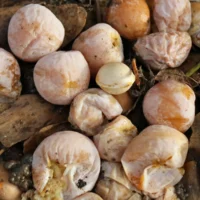The ginkgo tree can grow many meters high, but grows slowly and is also well suited for growing in pots or containers. It is hardy and can remain on the balcony all year round in many regions.
Location/light
Partly sunny locations with morning and evening sun are well suited. In a large pot or container in which the soil does not dry out within a few hours, the ginkgo tree can also tolerate the hot summer sun.
Soil/substrate
Ginkgo biloba thrives well in standard mixtures for potted plants, houseplants, herbs, vegetables and even tolerates substrates for succulents if they contain a lot of humus.
The small trees shown here grow in a mix of peat-free vegetable soil, bird sand, pumice gravel and lava gravel.

Watering
The soil should always be slightly moist. The soil ball is allowed to dry out moderately but not completely.
During the warm summer weeks, the water requirement is higher than in winter. So daily watering may be necessary. If there is water in the saucer for a few hours in summer, this is not waterlogging. However, the ginkgo tree does not like permanently wet feet.
Fertilizing
Liquid fertilizer can be applied monthly from spring to late summer in the concentration recommended by the manufacturer. Or in lower doses every week or every other week.
Sticks, pellets or granules can be added to the substrate in spring and summer.
Fertilizing is not necessary in the first year after purchase or repotting.
Overwintering
Ginkgo biloba can also be overwintered in a pot or container on the balcony. In cold regions, however, it should be protected from permafrost. Frozen soil can dry out.

Categories: Indoor Plants | Shrubs & Trees |

 Ginkgo
Ginkgo Ginkgo biloba
Ginkgo biloba